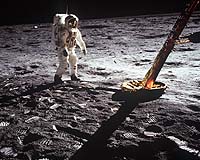 |
Paris (AFP) July 19, 2009 One of the many legacies of the Apollo space programme was the way it caused an extraordinary, enduring -- and, for some, troubling -- change in how we perceive the Universe and our place in it. Before, the Moon was distant and aloof, a symbol of everything that is unattainable, a place of dreams, an object of superstition and veneration. After being explored by Apollo 11 on July 20 1969, the Moon's enigma was stripped away. Human willpower and the rigour of science revealed it to be an arid, airless, inhospitable rock for which there was little use. "When we went there, we kind of demythologised, demystified the Moon," said Roger Launius, senior curator at the division of space history at the Smithsonian Institution in Washington. Apollo not only brought the Moon, almost literally, down to earth, it also opened up a perspective of space and humanity that would thrill, disappoint or isolate. Arguably the most famous photograph of the 20th century is "Earthrise," showing the blue planet floating in inky darkness. For the first time, we could see our home from the outside, a place of heart-wrenching beauty, a haven of life in the chill infinity of space. Some would see the image as a confirmation of God's gift to humanity, proof that Man had been singled out for divine benediction. They included two Apollo astronauts, James Irwin and Charles Duke. Others would see it as a daunting sign of our solitude. It showed how primitive we were, how very far we still had to advance before we could really travel in space, rather than make a risky lunar hop. The British physicist and novelist C.P. Snow argued that Apollo "as well as being the greatest exploration... was very near the final one" and predicted human civilisation would be "driven inward" by it. And there would be those who concluded that our only chance was to nurture our precious refuge, for there was simply nowhere else for us to go. "At the age of six, I watched Apollo 11 launch and (Neil) Armstrong take his small step," said the Reverend David Wilkinson, a Christian theologian at Durham University in northeastern England who trained as an astrophysicist before taking holy orders. "I was part of the generation excited to go into science as a result of this. Alongside its scientific achievements, its legacy is its effect on that generation. "But Apollo also raised some of the big questions of the place of human beings in the Universe, from our environmental responsibility to spirituality." Jacques Arnould, a Dominican friar who is a researcher at France's National Centre of Space Studies (CNES), says the Apollo images were a major spur to the environmental movement, which in the late 1960s was a small and an eclectic group of academics and hippies. "The astronauts, as they sped away from Earth, did not go into ecstasy about the stars. Instead, they said the Earth was beautiful, and fragile too, in words that stimulated ecological awareness. We are the inheritors of that awareness today," he said. "It was the first time in the history of humanity that we had a real sense of distance, as opposed to an imaginary one, with regard to the Earth. "We suddenly felt that all of us were living on this little scrap of blue planet, that all of us were onboard the same boat." Share This Article With Planet Earth
Related Links Image credit: The Alan Bean Gallery (web site) Mars News and Information at MarsDaily.com Lunar Dreams and more
 Video of first moon walk gets touch-up
Video of first moon walk gets touch-upWashington (AFP) July 16, 2009 NASA on Thursday unveiled restored video footage of man's first steps on the moon, 40 years to the day after Apollo 11 blasted off on its historic voyage into space. The first installment of a more extensive project, the video includes 15 restored key moments from the mission led by astronauts Neil Armstrong, Buzz Aldrin and Michael Collins, the US space agency said. The video was only ... read more |
|
| The content herein, unless otherwise known to be public domain, are Copyright 1995-2009 - SpaceDaily. AFP and UPI Wire Stories are copyright Agence France-Presse and United Press International. ESA Portal Reports are copyright European Space Agency. All NASA sourced material is public domain. Additional copyrights may apply in whole or part to other bona fide parties. Advertising does not imply endorsement,agreement or approval of any opinions, statements or information provided by SpaceDaily on any Web page published or hosted by SpaceDaily. Privacy Statement |